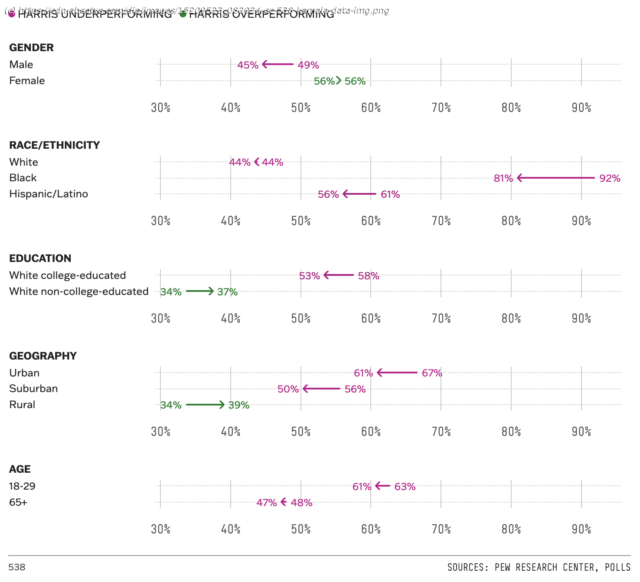Array
It has now been just over four weeks since President Joe Biden dropped out of the presidential race and Vice President Kamala Harris became the de facto nominee of the Democratic Party. Over that time, Harris and her campaign have taken steps to reintroduce her to the American people, reimagining Biden’s campaign to match her different personality and appeal to new voters.
DNC LIVE UPDATES: Barack Obama and Michelle expected to deliver speeches in Chicago
That has led to a lot of speculation about what the “Harris coalition” could look like in November – and how it could differ from Biden’s. To find out, we aggregated crosstabs for several key demographic groups from polls conducted since Biden dropped out of the race. Now, this data isn’t perfect – as subsets of the larger sample, crosstabs are subject to larger margins of error, and this is also just one month’s worth of data in what will end up being a three-and-a-half-month general-election campaign. But it is enough to give us an early sense of how the Harris coalition is developing. Relative to Biden’s performance in 2020, she’s made gains with some groups of voters, but there are still plenty of demographic groups with whom she’s underperforming.*
President Joe Biden’s share of the two-way vote among key demographic groups in 2020 compared with Vice President Kamala Harris’s share of the two-way vote among the same groups in an average of crosstabs in polls of the 2024 election conducted July 21-Aug. 17Another historic gender gap?
Since 1996, a majority of women have voted for the Democratic candidate for president, while men have only voted for the Democratic candidate in one year (2008). In addition, there has typically been a sizable difference in what percentage of the vote the Democratic candidate receives from men versus from women. The widest such gender gap in recent history occurred during the 2016 election, in which 58 percent of the two-party vote share among women went to former Secretary of State Hillary Clinton but only 44 percent of the two-party vote share among men did – a gap of 14 percentage points, according to the Pew Research Center’s validated voter surveys. In 2020, according to Pew, the gender gap fell back to 7 points, much more in line with the historical norm.
In 2022, there was some suggestion that the gender gap was widening in the wake of the Supreme Court’s decision in Dobbs v. Jackson Women’s Health Organization, but a significantly larger gap didn’t materialize. Despite concerns about abortion being top of mind for many voters in that election, there was ultimately only a 7-point gap between the percentage of women and men voting for Democrats.
Until Harris took over, this year’s gender gap was shaping up to be fairly typical: The average gender gap in polls conducted and released between the debate and Biden’s withdrawal was 9 points, and polls generally showed Biden performing about 3-5 points worse among both men and women than he did in 2020.**
RELATED: What to watch as the Democratic National Convention enters its 2nd day in Chicago
Since Harris took over, though, this appears to have changed. On average, Harris is performing about the same with women as Biden did in 2020; in polls conducted since the handover, Harris averages less than a point better than Biden’s 2020 two-party vote share among women. But among men, she’s performing an average of 4 points worse than Biden’s 2020 performance.
However, the campaign seems to have made gains with men since its launch: In polls conducted the first week of Harris’s candidacy, she averaged 43 percent of the male two-party vote, but in the last week, that average has grown to 46 percent. On the other hand, her polling among women has hardly budged over the course of the month.Harris has made gains among Black voters and urban voters
One of the biggest questions about the 2024 election to date has been whether nonwhite voters (particularly young Black voters) might be more likely to vote for former President Donald Trump than they were to vote for Republicans in previous elections. In an average of polls conducted and released between the debate and Biden’s withdrawal, Biden was earning only 77 percent of the Black two-party vote – significantly worse than the 92 percent he won among Black voters in 2020. Among Hispanic voters, the drop was less significant, but still meaningful: Biden was polling at 54 percent of the Hispanic vote, compared with the 61 percent of Hispanics who voted for him in 2020.






